Importance of PESTLE Analysis in Business Environment
VerifiedAdded on 2022/12/27
|12
|3695
|29
AI Summary
This study explores the importance of PESTLE analysis in understanding the external factors that influence a company's business environment. It discusses the political, economic, social, technological, legal, and environmental factors that can impact a company's decision-making process. The study also includes a PESTLE analysis of Pearson, a multinational education and publishing company based in the UK.
Contribute Materials
Your contribution can guide someone’s learning journey. Share your
documents today.

BUSINESS ENVIRONMENT
Secure Best Marks with AI Grader
Need help grading? Try our AI Grader for instant feedback on your assignments.
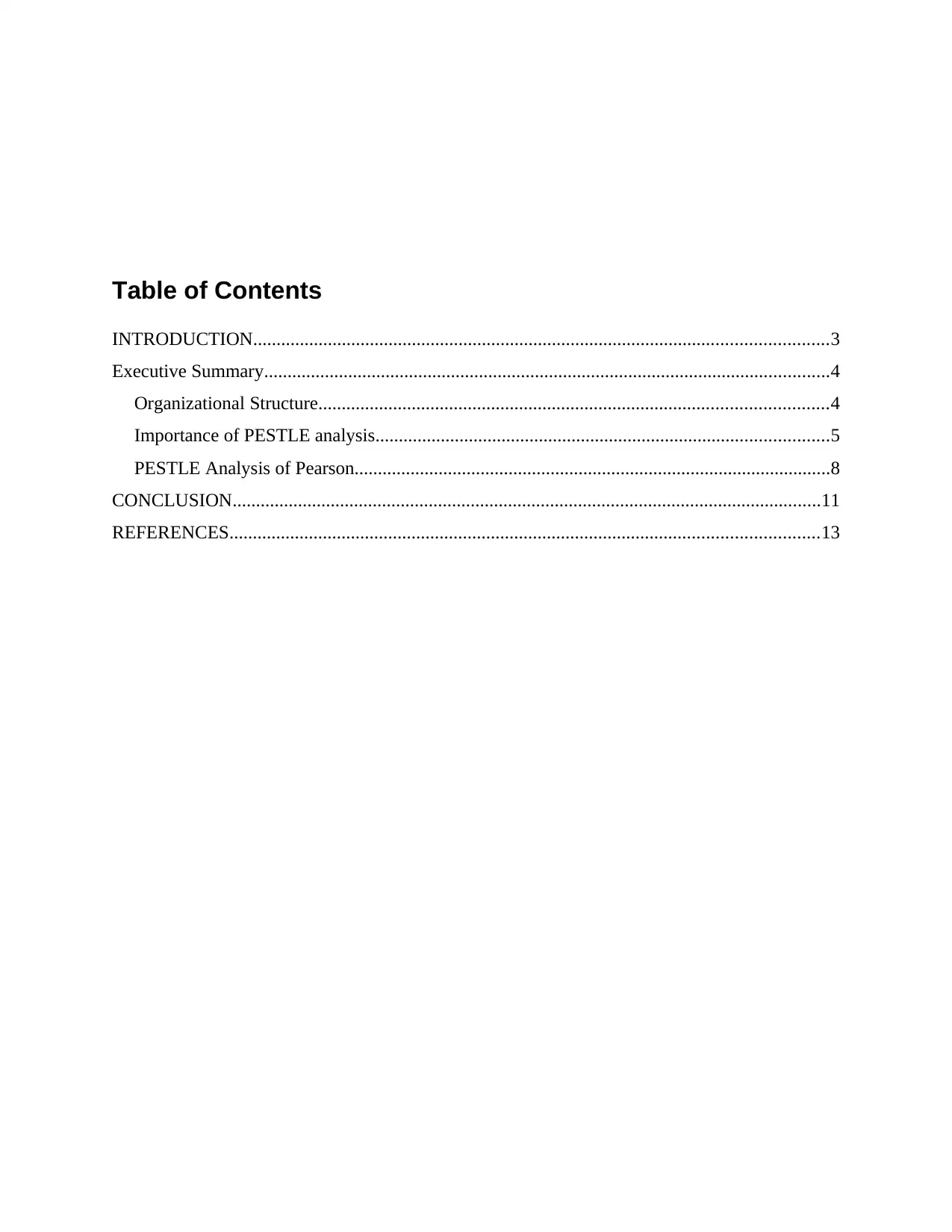
Table of Contents
INTRODUCTION...........................................................................................................................3
Executive Summary.........................................................................................................................4
Organizational Structure.............................................................................................................4
Importance of PESTLE analysis.................................................................................................5
PESTLE Analysis of Pearson......................................................................................................8
CONCLUSION..............................................................................................................................11
REFERENCES..............................................................................................................................13
INTRODUCTION...........................................................................................................................3
Executive Summary.........................................................................................................................4
Organizational Structure.............................................................................................................4
Importance of PESTLE analysis.................................................................................................5
PESTLE Analysis of Pearson......................................................................................................8
CONCLUSION..............................................................................................................................11
REFERENCES..............................................................................................................................13
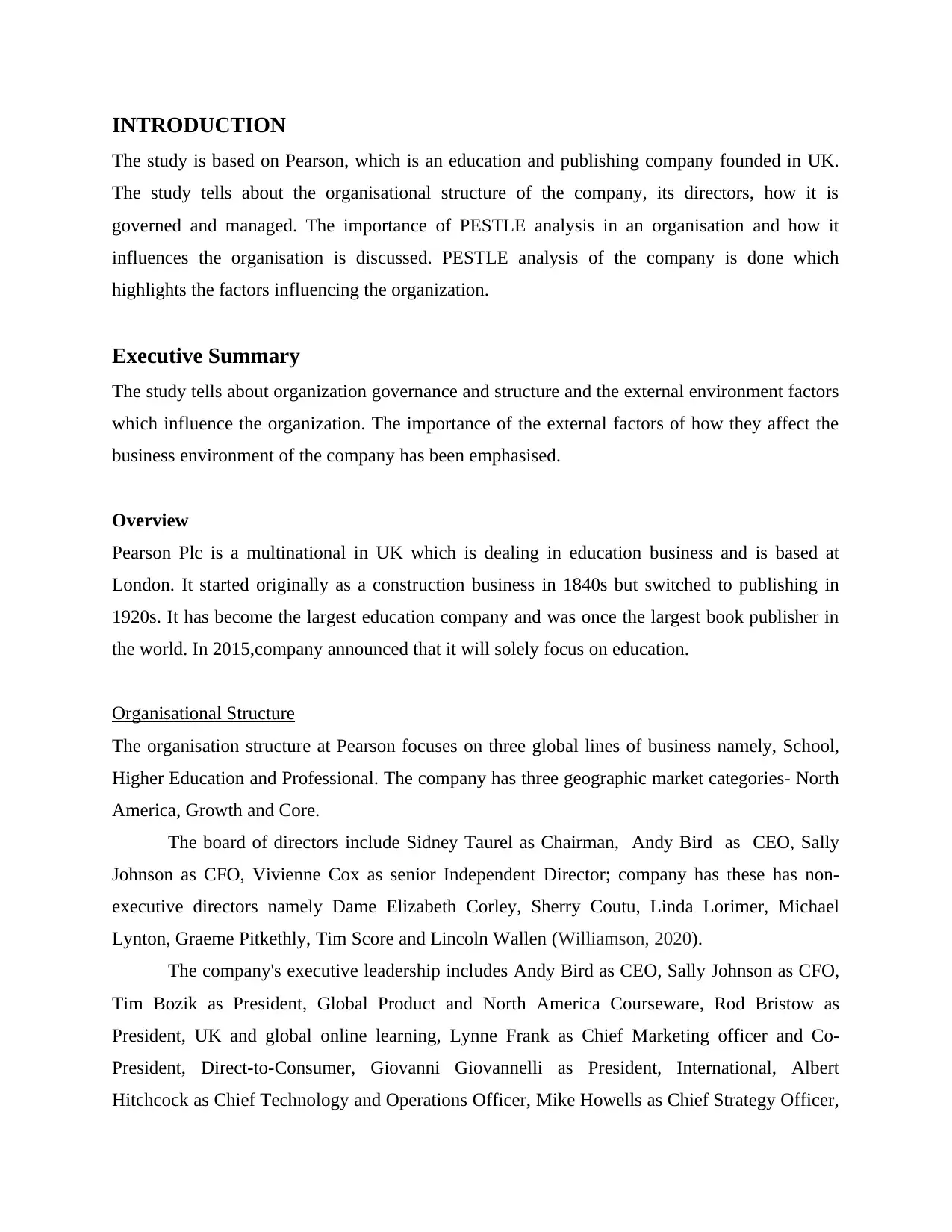
INTRODUCTION
The study is based on Pearson, which is an education and publishing company founded in UK.
The study tells about the organisational structure of the company, its directors, how it is
governed and managed. The importance of PESTLE analysis in an organisation and how it
influences the organisation is discussed. PESTLE analysis of the company is done which
highlights the factors influencing the organization.
Executive Summary
The study tells about organization governance and structure and the external environment factors
which influence the organization. The importance of the external factors of how they affect the
business environment of the company has been emphasised.
Overview
Pearson Plc is a multinational in UK which is dealing in education business and is based at
London. It started originally as a construction business in 1840s but switched to publishing in
1920s. It has become the largest education company and was once the largest book publisher in
the world. In 2015,company announced that it will solely focus on education.
Organisational Structure
The organisation structure at Pearson focuses on three global lines of business namely, School,
Higher Education and Professional. The company has three geographic market categories- North
America, Growth and Core.
The board of directors include Sidney Taurel as Chairman, Andy Bird as CEO, Sally
Johnson as CFO, Vivienne Cox as senior Independent Director; company has these has non-
executive directors namely Dame Elizabeth Corley, Sherry Coutu, Linda Lorimer, Michael
Lynton, Graeme Pitkethly, Tim Score and Lincoln Wallen (Williamson, 2020).
The company's executive leadership includes Andy Bird as CEO, Sally Johnson as CFO,
Tim Bozik as President, Global Product and North America Courseware, Rod Bristow as
President, UK and global online learning, Lynne Frank as Chief Marketing officer and Co-
President, Direct-to-Consumer, Giovanni Giovannelli as President, International, Albert
Hitchcock as Chief Technology and Operations Officer, Mike Howells as Chief Strategy Officer,
The study is based on Pearson, which is an education and publishing company founded in UK.
The study tells about the organisational structure of the company, its directors, how it is
governed and managed. The importance of PESTLE analysis in an organisation and how it
influences the organisation is discussed. PESTLE analysis of the company is done which
highlights the factors influencing the organization.
Executive Summary
The study tells about organization governance and structure and the external environment factors
which influence the organization. The importance of the external factors of how they affect the
business environment of the company has been emphasised.
Overview
Pearson Plc is a multinational in UK which is dealing in education business and is based at
London. It started originally as a construction business in 1840s but switched to publishing in
1920s. It has become the largest education company and was once the largest book publisher in
the world. In 2015,company announced that it will solely focus on education.
Organisational Structure
The organisation structure at Pearson focuses on three global lines of business namely, School,
Higher Education and Professional. The company has three geographic market categories- North
America, Growth and Core.
The board of directors include Sidney Taurel as Chairman, Andy Bird as CEO, Sally
Johnson as CFO, Vivienne Cox as senior Independent Director; company has these has non-
executive directors namely Dame Elizabeth Corley, Sherry Coutu, Linda Lorimer, Michael
Lynton, Graeme Pitkethly, Tim Score and Lincoln Wallen (Williamson, 2020).
The company's executive leadership includes Andy Bird as CEO, Sally Johnson as CFO,
Tim Bozik as President, Global Product and North America Courseware, Rod Bristow as
President, UK and global online learning, Lynne Frank as Chief Marketing officer and Co-
President, Direct-to-Consumer, Giovanni Giovannelli as President, International, Albert
Hitchcock as Chief Technology and Operations Officer, Mike Howells as Chief Strategy Officer,

Ishantha Lokuge as Chief Product Officer and Co-President, Direct to Consumer, Cinthia
Nespoli as chief legal officer, Anna Vikstrom Persson as Chief Human Resources Officer, Bob
Whelan as President, Pearson Assessment.
Talking of CEO Andy Bird, he was appointed to the Board on May 1,2020 and appointed
as Chief Executive Officer on 19 October 2020. Andy has a remarkable career spanning 35 years
in the media industry. Andy has spent 14 years working for Walt Disney, as firstly President and
then Chairman. Andy had done remarkable work in enhancing company's local presence in
countries around the world (Neis, Pereira and Maccari, 2017).
Speaking of Chairman Sidney Taurel, he has over 45 years of experience in business and
finance. He was appointed on January 1,2016. He is also the Director of IBM Corporation, where
he is serving the corporate governance committee. The chairman has commanded several
prominent posts in various sectors and is also an awarded person.
Importance of PESTLE analysis
This analysis is used to reduce business threats. It judges the macro external factors which can
influence a company's decision-making. The points which analysis addresses are:
a) Cost effectiveness: The only cost factor which the analysis involves is time. PESTLE can be
made very easily on a pen and paper basis.
b) Understanding of environment: Environments which are directly affecting or indirectly
affecting the business are noticed by this analysis (Perera, 2017).
c) Alertness development: It can narrow down on factors which are urgent address and require
attention of the company.
PESTLE analysis has the following factors associated in it:
a) Political: The factors which affect the business environment and trade markets are
government regulations. It includes factors like political stability, tax guidelines, trade
regulations, safety and employment laws. Government regulations can change with change in
government. With changing political structure, relations can change of a country with other. This
can lay effect on the business. The tariff rates can change which were imposed earlier by
previous government. Also, the tax policies can change for corporates by changing governments
Nespoli as chief legal officer, Anna Vikstrom Persson as Chief Human Resources Officer, Bob
Whelan as President, Pearson Assessment.
Talking of CEO Andy Bird, he was appointed to the Board on May 1,2020 and appointed
as Chief Executive Officer on 19 October 2020. Andy has a remarkable career spanning 35 years
in the media industry. Andy has spent 14 years working for Walt Disney, as firstly President and
then Chairman. Andy had done remarkable work in enhancing company's local presence in
countries around the world (Neis, Pereira and Maccari, 2017).
Speaking of Chairman Sidney Taurel, he has over 45 years of experience in business and
finance. He was appointed on January 1,2016. He is also the Director of IBM Corporation, where
he is serving the corporate governance committee. The chairman has commanded several
prominent posts in various sectors and is also an awarded person.
Importance of PESTLE analysis
This analysis is used to reduce business threats. It judges the macro external factors which can
influence a company's decision-making. The points which analysis addresses are:
a) Cost effectiveness: The only cost factor which the analysis involves is time. PESTLE can be
made very easily on a pen and paper basis.
b) Understanding of environment: Environments which are directly affecting or indirectly
affecting the business are noticed by this analysis (Perera, 2017).
c) Alertness development: It can narrow down on factors which are urgent address and require
attention of the company.
PESTLE analysis has the following factors associated in it:
a) Political: The factors which affect the business environment and trade markets are
government regulations. It includes factors like political stability, tax guidelines, trade
regulations, safety and employment laws. Government regulations can change with change in
government. With changing political structure, relations can change of a country with other. This
can lay effect on the business. The tariff rates can change which were imposed earlier by
previous government. Also, the tax policies can change for corporates by changing governments
Secure Best Marks with AI Grader
Need help grading? Try our AI Grader for instant feedback on your assignments.
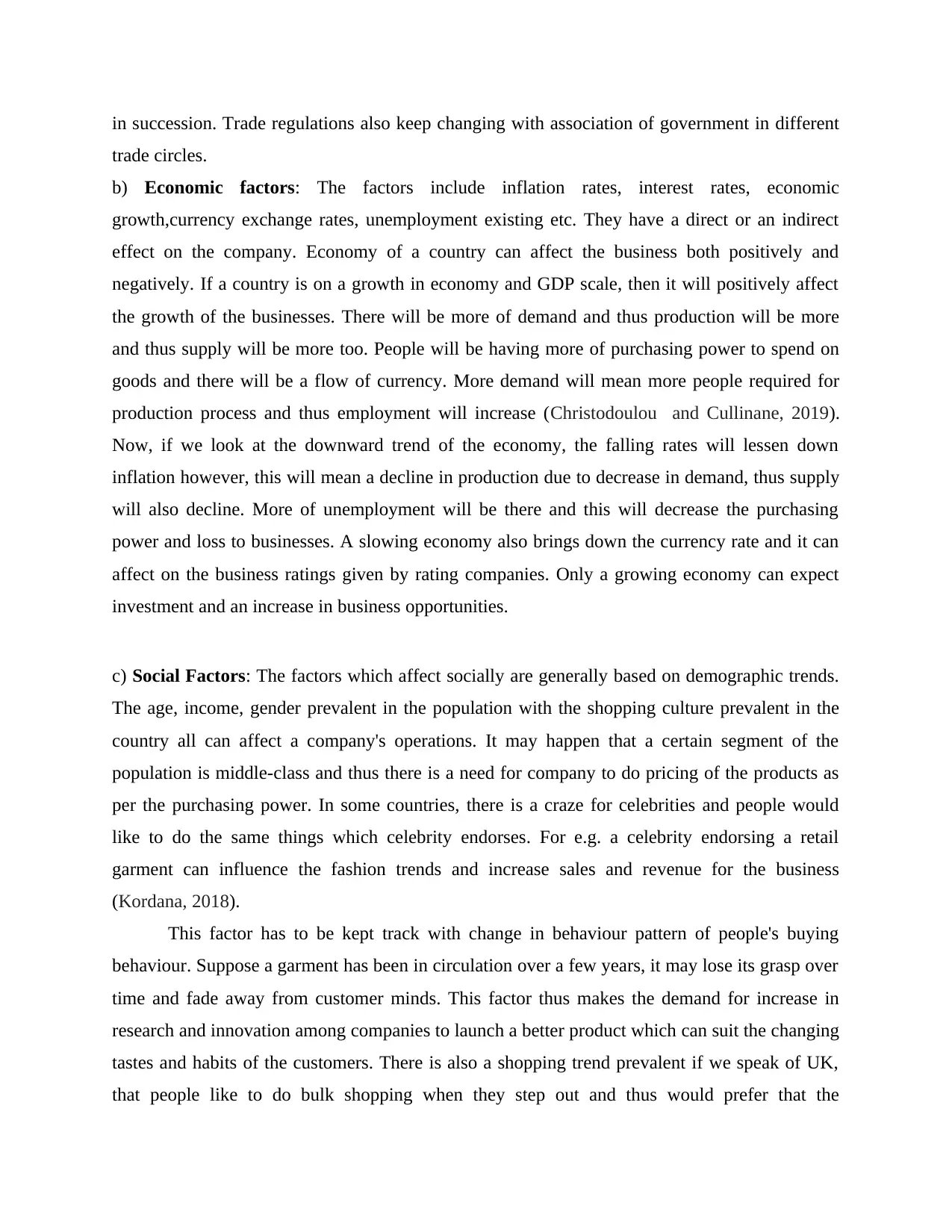
in succession. Trade regulations also keep changing with association of government in different
trade circles.
b) Economic factors: The factors include inflation rates, interest rates, economic
growth,currency exchange rates, unemployment existing etc. They have a direct or an indirect
effect on the company. Economy of a country can affect the business both positively and
negatively. If a country is on a growth in economy and GDP scale, then it will positively affect
the growth of the businesses. There will be more of demand and thus production will be more
and thus supply will be more too. People will be having more of purchasing power to spend on
goods and there will be a flow of currency. More demand will mean more people required for
production process and thus employment will increase (Christodoulou and Cullinane, 2019).
Now, if we look at the downward trend of the economy, the falling rates will lessen down
inflation however, this will mean a decline in production due to decrease in demand, thus supply
will also decline. More of unemployment will be there and this will decrease the purchasing
power and loss to businesses. A slowing economy also brings down the currency rate and it can
affect on the business ratings given by rating companies. Only a growing economy can expect
investment and an increase in business opportunities.
c) Social Factors: The factors which affect socially are generally based on demographic trends.
The age, income, gender prevalent in the population with the shopping culture prevalent in the
country all can affect a company's operations. It may happen that a certain segment of the
population is middle-class and thus there is a need for company to do pricing of the products as
per the purchasing power. In some countries, there is a craze for celebrities and people would
like to do the same things which celebrity endorses. For e.g. a celebrity endorsing a retail
garment can influence the fashion trends and increase sales and revenue for the business
(Kordana, 2018).
This factor has to be kept track with change in behaviour pattern of people's buying
behaviour. Suppose a garment has been in circulation over a few years, it may lose its grasp over
time and fade away from customer minds. This factor thus makes the demand for increase in
research and innovation among companies to launch a better product which can suit the changing
tastes and habits of the customers. There is also a shopping trend prevalent if we speak of UK,
that people like to do bulk shopping when they step out and thus would prefer that the
trade circles.
b) Economic factors: The factors include inflation rates, interest rates, economic
growth,currency exchange rates, unemployment existing etc. They have a direct or an indirect
effect on the company. Economy of a country can affect the business both positively and
negatively. If a country is on a growth in economy and GDP scale, then it will positively affect
the growth of the businesses. There will be more of demand and thus production will be more
and thus supply will be more too. People will be having more of purchasing power to spend on
goods and there will be a flow of currency. More demand will mean more people required for
production process and thus employment will increase (Christodoulou and Cullinane, 2019).
Now, if we look at the downward trend of the economy, the falling rates will lessen down
inflation however, this will mean a decline in production due to decrease in demand, thus supply
will also decline. More of unemployment will be there and this will decrease the purchasing
power and loss to businesses. A slowing economy also brings down the currency rate and it can
affect on the business ratings given by rating companies. Only a growing economy can expect
investment and an increase in business opportunities.
c) Social Factors: The factors which affect socially are generally based on demographic trends.
The age, income, gender prevalent in the population with the shopping culture prevalent in the
country all can affect a company's operations. It may happen that a certain segment of the
population is middle-class and thus there is a need for company to do pricing of the products as
per the purchasing power. In some countries, there is a craze for celebrities and people would
like to do the same things which celebrity endorses. For e.g. a celebrity endorsing a retail
garment can influence the fashion trends and increase sales and revenue for the business
(Kordana, 2018).
This factor has to be kept track with change in behaviour pattern of people's buying
behaviour. Suppose a garment has been in circulation over a few years, it may lose its grasp over
time and fade away from customer minds. This factor thus makes the demand for increase in
research and innovation among companies to launch a better product which can suit the changing
tastes and habits of the customers. There is also a shopping trend prevalent if we speak of UK,
that people like to do bulk shopping when they step out and thus would prefer that the

purchasable can be got at a store which has multi variety of products. This can affect business
policy who will then think of offering multi variety instead of narrowing down on some product
line.
d) Technological factors: The era at present is a global one marked with ever changing
technology. In previous decades, the relevance of technology was not as much as the present day
scenario. With advent of online shopping, it has made easier for the business to expand their
customer segment as more and more people are going online. People at their convenience can
buy products considering a variety of range which is offered and online payments can be done
through various modes available. Apart from this, advent of social media has also changed the
path of marketing and branding. Companies have their social media accounts on which they link
up with their customers and also gather feedback of their products. It has also become the
platform for companies to make their image of a sustainable environment conscious brand
(Kordana, 2018).
Now, the age has come of automation in which artificial intelligence has been looming
large on the way of company's operations. It has got to do with complex and lengthy
programming done with automation tools to speed up the process. The changing business
scenario will see the automation being taken up by BPOs, retail businesses in near future.
e) Legal factors: This factor has to do with laws concerned to an organisation like labour laws,
discrimination laws, consumer protection laws, copyright and patent laws, safety laws etc.
Following the legal principles for a company is necessary as it helps the company to stay away
from the legal hassles of the country they are operating in. The companies have to check in the
labour laws, the minimum wages to be paid, the working hours schedule, overtime to be given,
the provisions that has to be taken by the company for safeguarding the health and safety
concerns of the workers. The companies have to provide equal pay scale to men and women
(Bismark and et.al., 2018). The company products have to be of acceptable quality which does
not have adulteration, thus abiding by the consumer protection law. There has to be followed a
bar set for minimum and maximum selling price of goods by the company. This way the country
decides to check any unfair competition. The organisations cannot copy other company's
policy who will then think of offering multi variety instead of narrowing down on some product
line.
d) Technological factors: The era at present is a global one marked with ever changing
technology. In previous decades, the relevance of technology was not as much as the present day
scenario. With advent of online shopping, it has made easier for the business to expand their
customer segment as more and more people are going online. People at their convenience can
buy products considering a variety of range which is offered and online payments can be done
through various modes available. Apart from this, advent of social media has also changed the
path of marketing and branding. Companies have their social media accounts on which they link
up with their customers and also gather feedback of their products. It has also become the
platform for companies to make their image of a sustainable environment conscious brand
(Kordana, 2018).
Now, the age has come of automation in which artificial intelligence has been looming
large on the way of company's operations. It has got to do with complex and lengthy
programming done with automation tools to speed up the process. The changing business
scenario will see the automation being taken up by BPOs, retail businesses in near future.
e) Legal factors: This factor has to do with laws concerned to an organisation like labour laws,
discrimination laws, consumer protection laws, copyright and patent laws, safety laws etc.
Following the legal principles for a company is necessary as it helps the company to stay away
from the legal hassles of the country they are operating in. The companies have to check in the
labour laws, the minimum wages to be paid, the working hours schedule, overtime to be given,
the provisions that has to be taken by the company for safeguarding the health and safety
concerns of the workers. The companies have to provide equal pay scale to men and women
(Bismark and et.al., 2018). The company products have to be of acceptable quality which does
not have adulteration, thus abiding by the consumer protection law. There has to be followed a
bar set for minimum and maximum selling price of goods by the company. This way the country
decides to check any unfair competition. The organisations cannot copy other company's
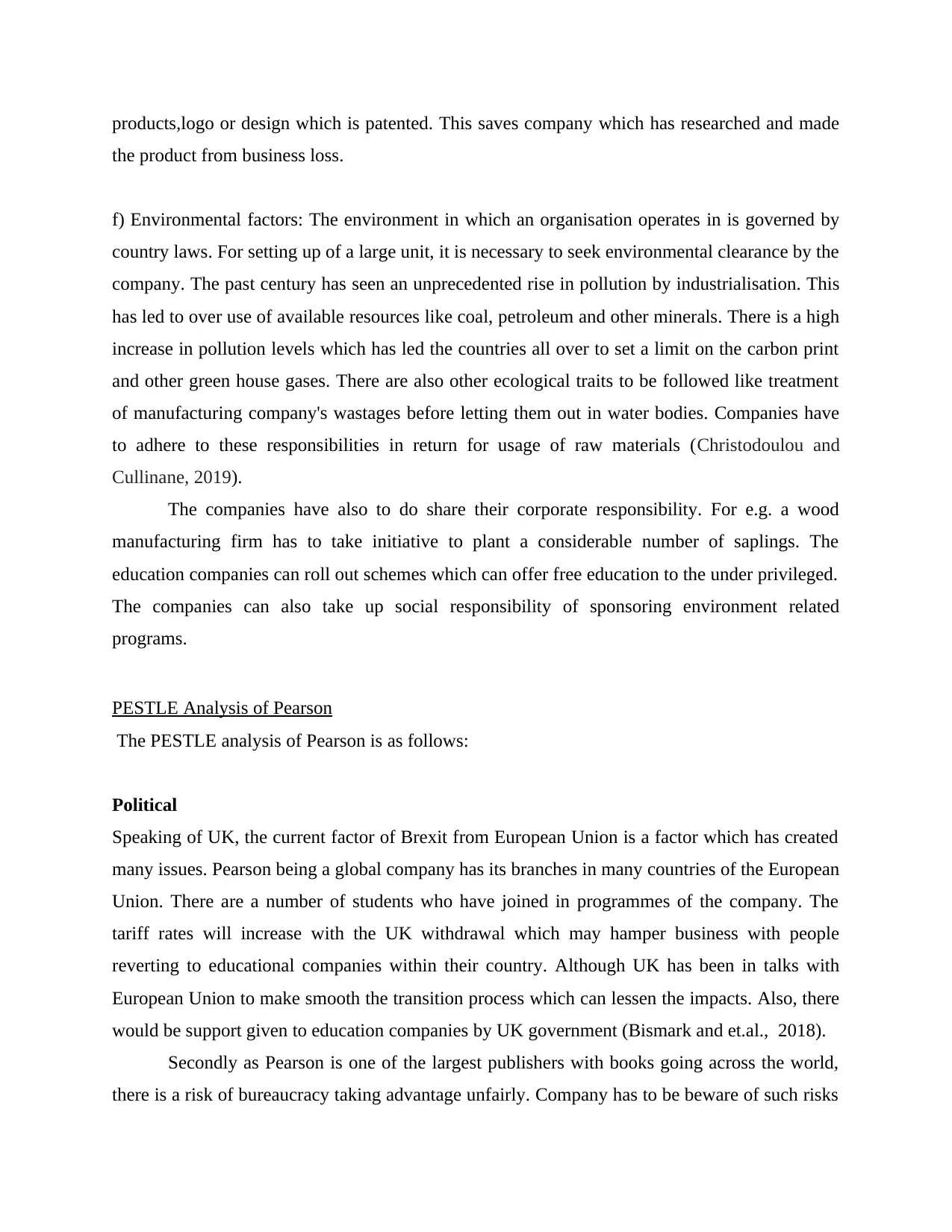
products,logo or design which is patented. This saves company which has researched and made
the product from business loss.
f) Environmental factors: The environment in which an organisation operates in is governed by
country laws. For setting up of a large unit, it is necessary to seek environmental clearance by the
company. The past century has seen an unprecedented rise in pollution by industrialisation. This
has led to over use of available resources like coal, petroleum and other minerals. There is a high
increase in pollution levels which has led the countries all over to set a limit on the carbon print
and other green house gases. There are also other ecological traits to be followed like treatment
of manufacturing company's wastages before letting them out in water bodies. Companies have
to adhere to these responsibilities in return for usage of raw materials (Christodoulou and
Cullinane, 2019).
The companies have also to do share their corporate responsibility. For e.g. a wood
manufacturing firm has to take initiative to plant a considerable number of saplings. The
education companies can roll out schemes which can offer free education to the under privileged.
The companies can also take up social responsibility of sponsoring environment related
programs.
PESTLE Analysis of Pearson
The PESTLE analysis of Pearson is as follows:
Political
Speaking of UK, the current factor of Brexit from European Union is a factor which has created
many issues. Pearson being a global company has its branches in many countries of the European
Union. There are a number of students who have joined in programmes of the company. The
tariff rates will increase with the UK withdrawal which may hamper business with people
reverting to educational companies within their country. Although UK has been in talks with
European Union to make smooth the transition process which can lessen the impacts. Also, there
would be support given to education companies by UK government (Bismark and et.al., 2018).
Secondly as Pearson is one of the largest publishers with books going across the world,
there is a risk of bureaucracy taking advantage unfairly. Company has to be beware of such risks
the product from business loss.
f) Environmental factors: The environment in which an organisation operates in is governed by
country laws. For setting up of a large unit, it is necessary to seek environmental clearance by the
company. The past century has seen an unprecedented rise in pollution by industrialisation. This
has led to over use of available resources like coal, petroleum and other minerals. There is a high
increase in pollution levels which has led the countries all over to set a limit on the carbon print
and other green house gases. There are also other ecological traits to be followed like treatment
of manufacturing company's wastages before letting them out in water bodies. Companies have
to adhere to these responsibilities in return for usage of raw materials (Christodoulou and
Cullinane, 2019).
The companies have also to do share their corporate responsibility. For e.g. a wood
manufacturing firm has to take initiative to plant a considerable number of saplings. The
education companies can roll out schemes which can offer free education to the under privileged.
The companies can also take up social responsibility of sponsoring environment related
programs.
PESTLE Analysis of Pearson
The PESTLE analysis of Pearson is as follows:
Political
Speaking of UK, the current factor of Brexit from European Union is a factor which has created
many issues. Pearson being a global company has its branches in many countries of the European
Union. There are a number of students who have joined in programmes of the company. The
tariff rates will increase with the UK withdrawal which may hamper business with people
reverting to educational companies within their country. Although UK has been in talks with
European Union to make smooth the transition process which can lessen the impacts. Also, there
would be support given to education companies by UK government (Bismark and et.al., 2018).
Secondly as Pearson is one of the largest publishers with books going across the world,
there is a risk of bureaucracy taking advantage unfairly. Company has to be beware of such risks
Paraphrase This Document
Need a fresh take? Get an instant paraphrase of this document with our AI Paraphraser

in the service sector and have to be in a complete know how of the legal systems supporting the
education sector to wade away these risks. The company management also has to be aware of the
anti-trust laws in the publishing sector.
Thirdly, company has to keep itself update of the tax regulations prevalent in UK. It has
to find ways in which tax rebate can come with investment in government schemes.
The industrial safety regulations have to be followed to be free of any legal penalties and
also follow an ethical approach. Caution has also to be taken in product labelling and logo with
other requirements in publishing (Dalirazar and Sabzi, 2020).
The wage legislation of timely wages with overtime has to be followed while also
following the work week regulations in publishing.
Pricing regulations have also to be checked for price regulatory mechanism to be
followed in publishing service.
Economic
The economic factors influencing Pearson is firstly, the type of economy of UK in which it has
operating base. The stability of the UK economy is bound to influence the company and its
operations. Macro environment factors such as inflation rate, savings rate, interest rate, foreign
exchange rate influence the company's business. If there is high inflation, the company may have
to price its products a bit higher as the publishing costs will rise and vice-versa. If the savings
rate is high, spending will be less and hence, the sale of goods for the company will be less. As
the company is a global organisation, currency rates can become another influential factor as
they fluctuate with changing market conditions. The revenue realised will thus be influenced.
The comparative advantages of host country in which company has branches can be realised if
there is a potential market and soundness of the economy. The education level in the economy
which company is operating is also bound to influence as sales will be more where the education
level is high (Rusu and Roman, 2018).
Company is also influenced by other factors like labour costs and productivity in the
economy.
education sector to wade away these risks. The company management also has to be aware of the
anti-trust laws in the publishing sector.
Thirdly, company has to keep itself update of the tax regulations prevalent in UK. It has
to find ways in which tax rebate can come with investment in government schemes.
The industrial safety regulations have to be followed to be free of any legal penalties and
also follow an ethical approach. Caution has also to be taken in product labelling and logo with
other requirements in publishing (Dalirazar and Sabzi, 2020).
The wage legislation of timely wages with overtime has to be followed while also
following the work week regulations in publishing.
Pricing regulations have also to be checked for price regulatory mechanism to be
followed in publishing service.
Economic
The economic factors influencing Pearson is firstly, the type of economy of UK in which it has
operating base. The stability of the UK economy is bound to influence the company and its
operations. Macro environment factors such as inflation rate, savings rate, interest rate, foreign
exchange rate influence the company's business. If there is high inflation, the company may have
to price its products a bit higher as the publishing costs will rise and vice-versa. If the savings
rate is high, spending will be less and hence, the sale of goods for the company will be less. As
the company is a global organisation, currency rates can become another influential factor as
they fluctuate with changing market conditions. The revenue realised will thus be influenced.
The comparative advantages of host country in which company has branches can be realised if
there is a potential market and soundness of the economy. The education level in the economy
which company is operating is also bound to influence as sales will be more where the education
level is high (Rusu and Roman, 2018).
Company is also influenced by other factors like labour costs and productivity in the
economy.
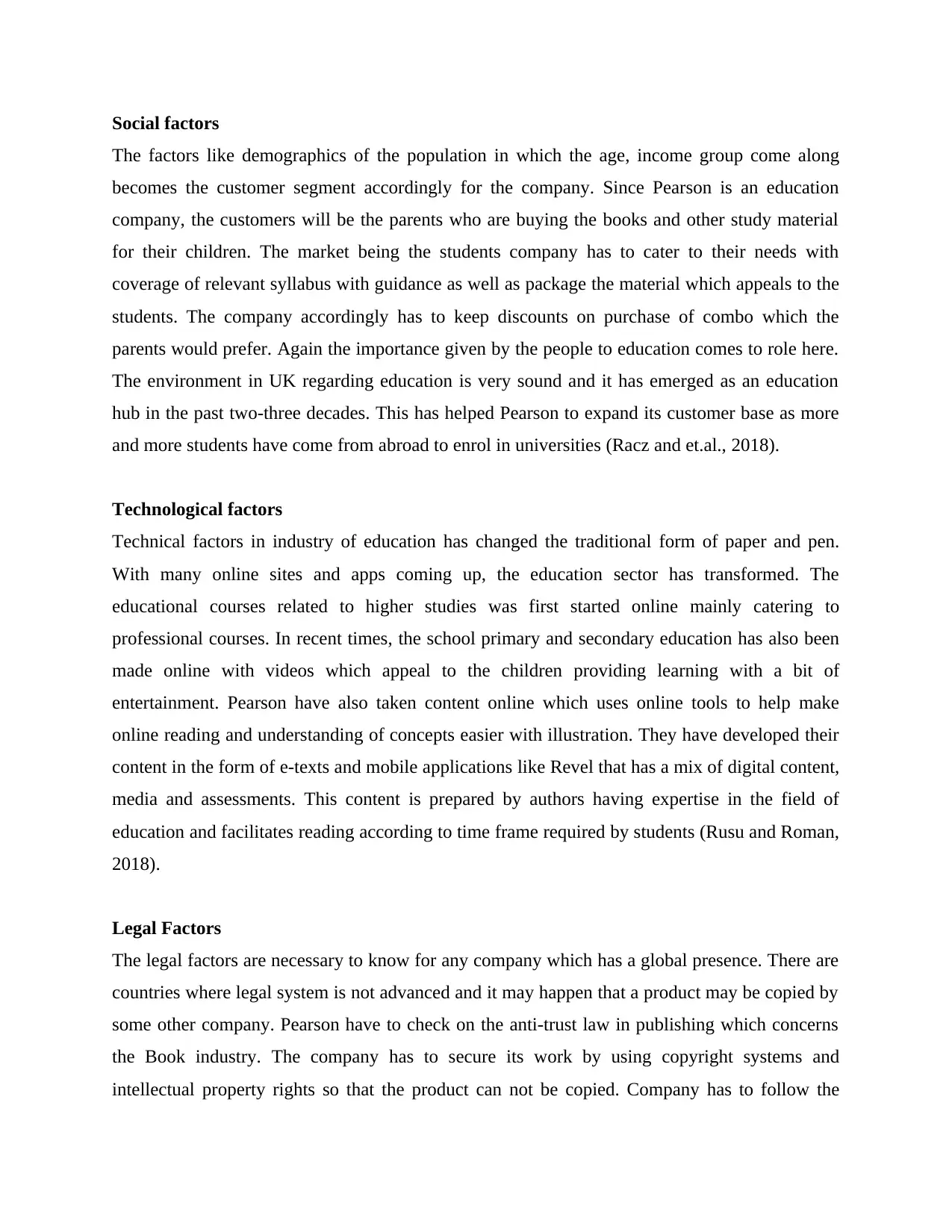
Social factors
The factors like demographics of the population in which the age, income group come along
becomes the customer segment accordingly for the company. Since Pearson is an education
company, the customers will be the parents who are buying the books and other study material
for their children. The market being the students company has to cater to their needs with
coverage of relevant syllabus with guidance as well as package the material which appeals to the
students. The company accordingly has to keep discounts on purchase of combo which the
parents would prefer. Again the importance given by the people to education comes to role here.
The environment in UK regarding education is very sound and it has emerged as an education
hub in the past two-three decades. This has helped Pearson to expand its customer base as more
and more students have come from abroad to enrol in universities (Racz and et.al., 2018).
Technological factors
Technical factors in industry of education has changed the traditional form of paper and pen.
With many online sites and apps coming up, the education sector has transformed. The
educational courses related to higher studies was first started online mainly catering to
professional courses. In recent times, the school primary and secondary education has also been
made online with videos which appeal to the children providing learning with a bit of
entertainment. Pearson have also taken content online which uses online tools to help make
online reading and understanding of concepts easier with illustration. They have developed their
content in the form of e-texts and mobile applications like Revel that has a mix of digital content,
media and assessments. This content is prepared by authors having expertise in the field of
education and facilitates reading according to time frame required by students (Rusu and Roman,
2018).
Legal Factors
The legal factors are necessary to know for any company which has a global presence. There are
countries where legal system is not advanced and it may happen that a product may be copied by
some other company. Pearson have to check on the anti-trust law in publishing which concerns
the Book industry. The company has to secure its work by using copyright systems and
intellectual property rights so that the product can not be copied. Company has to follow the
The factors like demographics of the population in which the age, income group come along
becomes the customer segment accordingly for the company. Since Pearson is an education
company, the customers will be the parents who are buying the books and other study material
for their children. The market being the students company has to cater to their needs with
coverage of relevant syllabus with guidance as well as package the material which appeals to the
students. The company accordingly has to keep discounts on purchase of combo which the
parents would prefer. Again the importance given by the people to education comes to role here.
The environment in UK regarding education is very sound and it has emerged as an education
hub in the past two-three decades. This has helped Pearson to expand its customer base as more
and more students have come from abroad to enrol in universities (Racz and et.al., 2018).
Technological factors
Technical factors in industry of education has changed the traditional form of paper and pen.
With many online sites and apps coming up, the education sector has transformed. The
educational courses related to higher studies was first started online mainly catering to
professional courses. In recent times, the school primary and secondary education has also been
made online with videos which appeal to the children providing learning with a bit of
entertainment. Pearson have also taken content online which uses online tools to help make
online reading and understanding of concepts easier with illustration. They have developed their
content in the form of e-texts and mobile applications like Revel that has a mix of digital content,
media and assessments. This content is prepared by authors having expertise in the field of
education and facilitates reading according to time frame required by students (Rusu and Roman,
2018).
Legal Factors
The legal factors are necessary to know for any company which has a global presence. There are
countries where legal system is not advanced and it may happen that a product may be copied by
some other company. Pearson have to check on the anti-trust law in publishing which concerns
the Book industry. The company has to secure its work by using copyright systems and
intellectual property rights so that the product can not be copied. Company has to follow the
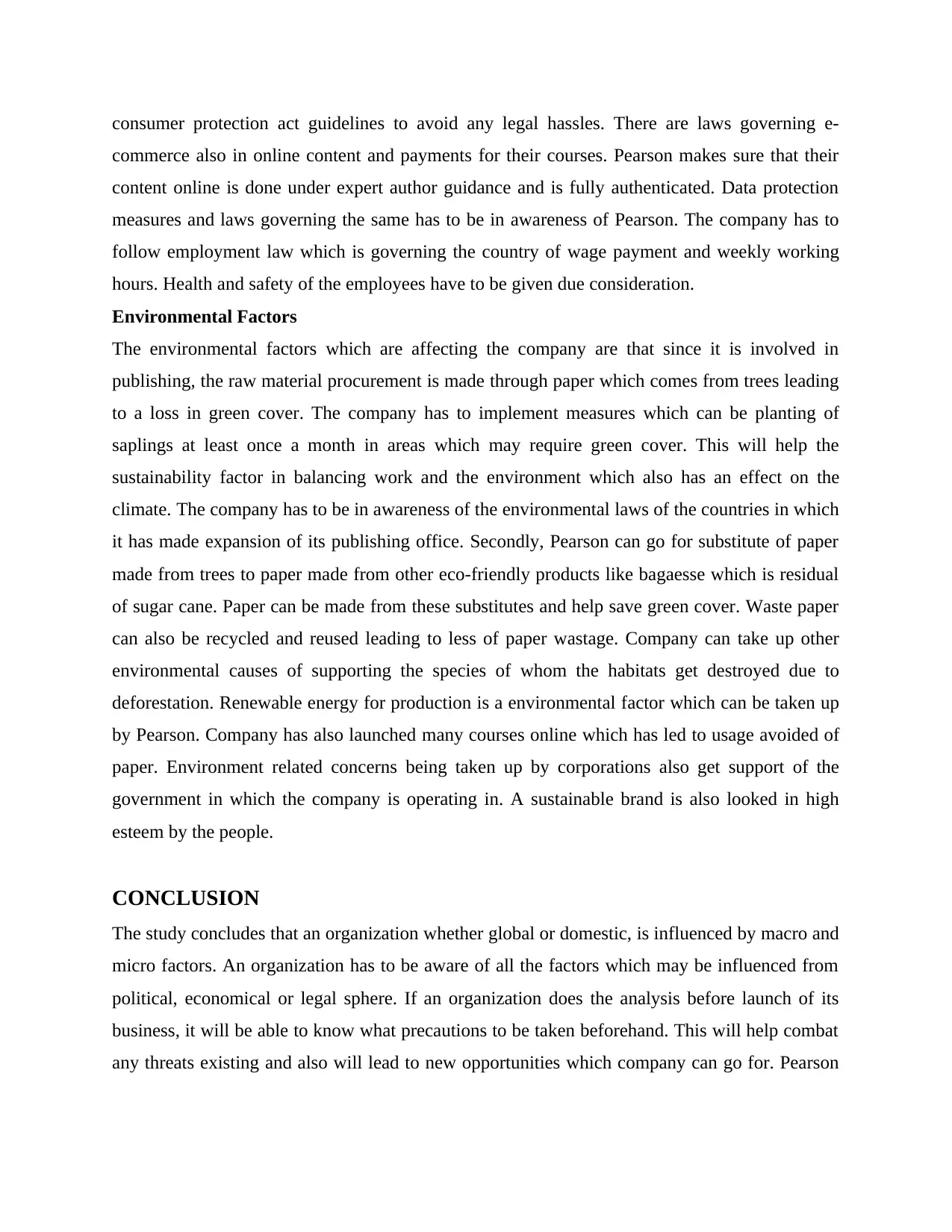
consumer protection act guidelines to avoid any legal hassles. There are laws governing e-
commerce also in online content and payments for their courses. Pearson makes sure that their
content online is done under expert author guidance and is fully authenticated. Data protection
measures and laws governing the same has to be in awareness of Pearson. The company has to
follow employment law which is governing the country of wage payment and weekly working
hours. Health and safety of the employees have to be given due consideration.
Environmental Factors
The environmental factors which are affecting the company are that since it is involved in
publishing, the raw material procurement is made through paper which comes from trees leading
to a loss in green cover. The company has to implement measures which can be planting of
saplings at least once a month in areas which may require green cover. This will help the
sustainability factor in balancing work and the environment which also has an effect on the
climate. The company has to be in awareness of the environmental laws of the countries in which
it has made expansion of its publishing office. Secondly, Pearson can go for substitute of paper
made from trees to paper made from other eco-friendly products like bagaesse which is residual
of sugar cane. Paper can be made from these substitutes and help save green cover. Waste paper
can also be recycled and reused leading to less of paper wastage. Company can take up other
environmental causes of supporting the species of whom the habitats get destroyed due to
deforestation. Renewable energy for production is a environmental factor which can be taken up
by Pearson. Company has also launched many courses online which has led to usage avoided of
paper. Environment related concerns being taken up by corporations also get support of the
government in which the company is operating in. A sustainable brand is also looked in high
esteem by the people.
CONCLUSION
The study concludes that an organization whether global or domestic, is influenced by macro and
micro factors. An organization has to be aware of all the factors which may be influenced from
political, economical or legal sphere. If an organization does the analysis before launch of its
business, it will be able to know what precautions to be taken beforehand. This will help combat
any threats existing and also will lead to new opportunities which company can go for. Pearson
commerce also in online content and payments for their courses. Pearson makes sure that their
content online is done under expert author guidance and is fully authenticated. Data protection
measures and laws governing the same has to be in awareness of Pearson. The company has to
follow employment law which is governing the country of wage payment and weekly working
hours. Health and safety of the employees have to be given due consideration.
Environmental Factors
The environmental factors which are affecting the company are that since it is involved in
publishing, the raw material procurement is made through paper which comes from trees leading
to a loss in green cover. The company has to implement measures which can be planting of
saplings at least once a month in areas which may require green cover. This will help the
sustainability factor in balancing work and the environment which also has an effect on the
climate. The company has to be in awareness of the environmental laws of the countries in which
it has made expansion of its publishing office. Secondly, Pearson can go for substitute of paper
made from trees to paper made from other eco-friendly products like bagaesse which is residual
of sugar cane. Paper can be made from these substitutes and help save green cover. Waste paper
can also be recycled and reused leading to less of paper wastage. Company can take up other
environmental causes of supporting the species of whom the habitats get destroyed due to
deforestation. Renewable energy for production is a environmental factor which can be taken up
by Pearson. Company has also launched many courses online which has led to usage avoided of
paper. Environment related concerns being taken up by corporations also get support of the
government in which the company is operating in. A sustainable brand is also looked in high
esteem by the people.
CONCLUSION
The study concludes that an organization whether global or domestic, is influenced by macro and
micro factors. An organization has to be aware of all the factors which may be influenced from
political, economical or legal sphere. If an organization does the analysis before launch of its
business, it will be able to know what precautions to be taken beforehand. This will help combat
any threats existing and also will lead to new opportunities which company can go for. Pearson
Secure Best Marks with AI Grader
Need help grading? Try our AI Grader for instant feedback on your assignments.
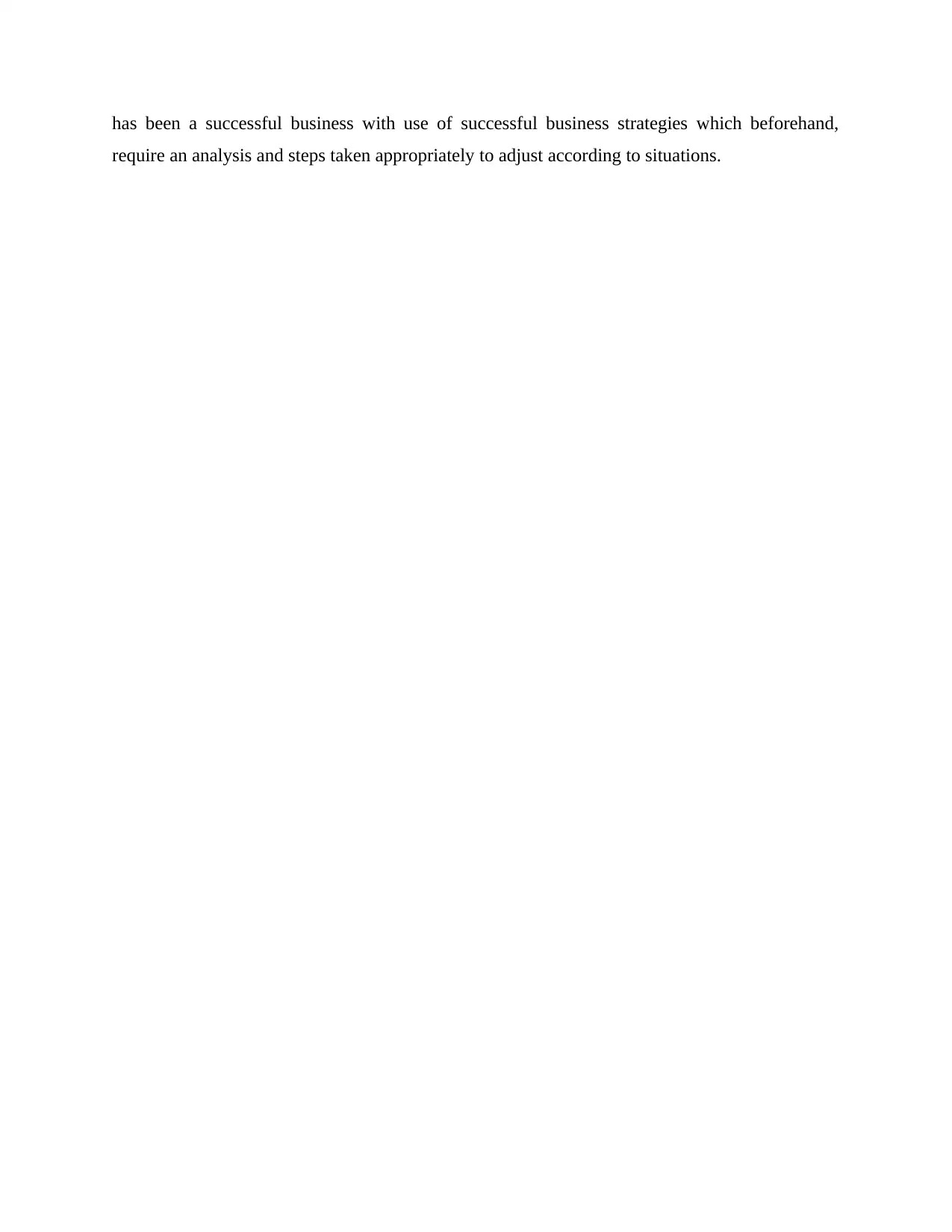
has been a successful business with use of successful business strategies which beforehand,
require an analysis and steps taken appropriately to adjust according to situations.
require an analysis and steps taken appropriately to adjust according to situations.
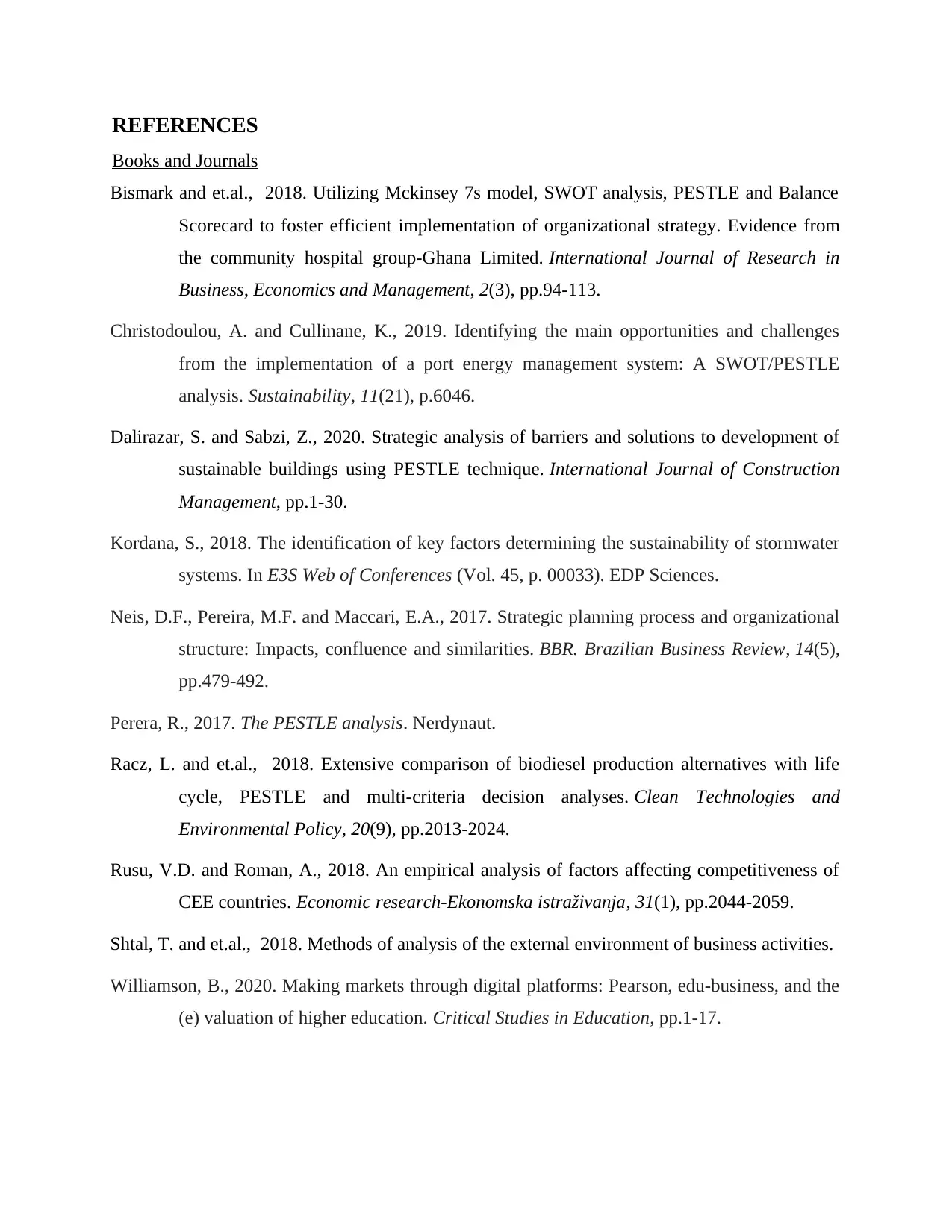
REFERENCES
Books and Journals
Bismark and et.al., 2018. Utilizing Mckinsey 7s model, SWOT analysis, PESTLE and Balance
Scorecard to foster efficient implementation of organizational strategy. Evidence from
the community hospital group-Ghana Limited. International Journal of Research in
Business, Economics and Management, 2(3), pp.94-113.
Christodoulou, A. and Cullinane, K., 2019. Identifying the main opportunities and challenges
from the implementation of a port energy management system: A SWOT/PESTLE
analysis. Sustainability, 11(21), p.6046.
Dalirazar, S. and Sabzi, Z., 2020. Strategic analysis of barriers and solutions to development of
sustainable buildings using PESTLE technique. International Journal of Construction
Management, pp.1-30.
Kordana, S., 2018. The identification of key factors determining the sustainability of stormwater
systems. In E3S Web of Conferences (Vol. 45, p. 00033). EDP Sciences.
Neis, D.F., Pereira, M.F. and Maccari, E.A., 2017. Strategic planning process and organizational
structure: Impacts, confluence and similarities. BBR. Brazilian Business Review, 14(5),
pp.479-492.
Perera, R., 2017. The PESTLE analysis. Nerdynaut.
Racz, L. and et.al., 2018. Extensive comparison of biodiesel production alternatives with life
cycle, PESTLE and multi-criteria decision analyses. Clean Technologies and
Environmental Policy, 20(9), pp.2013-2024.
Rusu, V.D. and Roman, A., 2018. An empirical analysis of factors affecting competitiveness of
CEE countries. Economic research-Ekonomska istraživanja, 31(1), pp.2044-2059.
Shtal, T. and et.al., 2018. Methods of analysis of the external environment of business activities.
Williamson, B., 2020. Making markets through digital platforms: Pearson, edu-business, and the
(e) valuation of higher education. Critical Studies in Education, pp.1-17.
Books and Journals
Bismark and et.al., 2018. Utilizing Mckinsey 7s model, SWOT analysis, PESTLE and Balance
Scorecard to foster efficient implementation of organizational strategy. Evidence from
the community hospital group-Ghana Limited. International Journal of Research in
Business, Economics and Management, 2(3), pp.94-113.
Christodoulou, A. and Cullinane, K., 2019. Identifying the main opportunities and challenges
from the implementation of a port energy management system: A SWOT/PESTLE
analysis. Sustainability, 11(21), p.6046.
Dalirazar, S. and Sabzi, Z., 2020. Strategic analysis of barriers and solutions to development of
sustainable buildings using PESTLE technique. International Journal of Construction
Management, pp.1-30.
Kordana, S., 2018. The identification of key factors determining the sustainability of stormwater
systems. In E3S Web of Conferences (Vol. 45, p. 00033). EDP Sciences.
Neis, D.F., Pereira, M.F. and Maccari, E.A., 2017. Strategic planning process and organizational
structure: Impacts, confluence and similarities. BBR. Brazilian Business Review, 14(5),
pp.479-492.
Perera, R., 2017. The PESTLE analysis. Nerdynaut.
Racz, L. and et.al., 2018. Extensive comparison of biodiesel production alternatives with life
cycle, PESTLE and multi-criteria decision analyses. Clean Technologies and
Environmental Policy, 20(9), pp.2013-2024.
Rusu, V.D. and Roman, A., 2018. An empirical analysis of factors affecting competitiveness of
CEE countries. Economic research-Ekonomska istraživanja, 31(1), pp.2044-2059.
Shtal, T. and et.al., 2018. Methods of analysis of the external environment of business activities.
Williamson, B., 2020. Making markets through digital platforms: Pearson, edu-business, and the
(e) valuation of higher education. Critical Studies in Education, pp.1-17.
1 out of 12
Related Documents
Your All-in-One AI-Powered Toolkit for Academic Success.
+13062052269
info@desklib.com
Available 24*7 on WhatsApp / Email
![[object Object]](/_next/static/media/star-bottom.7253800d.svg)
Unlock your academic potential
© 2024 | Zucol Services PVT LTD | All rights reserved.





